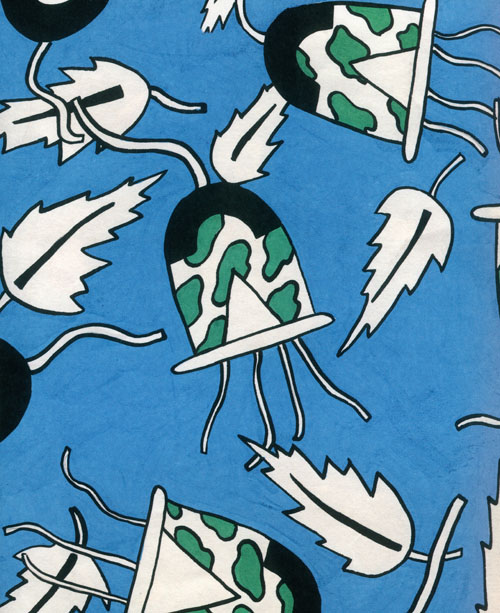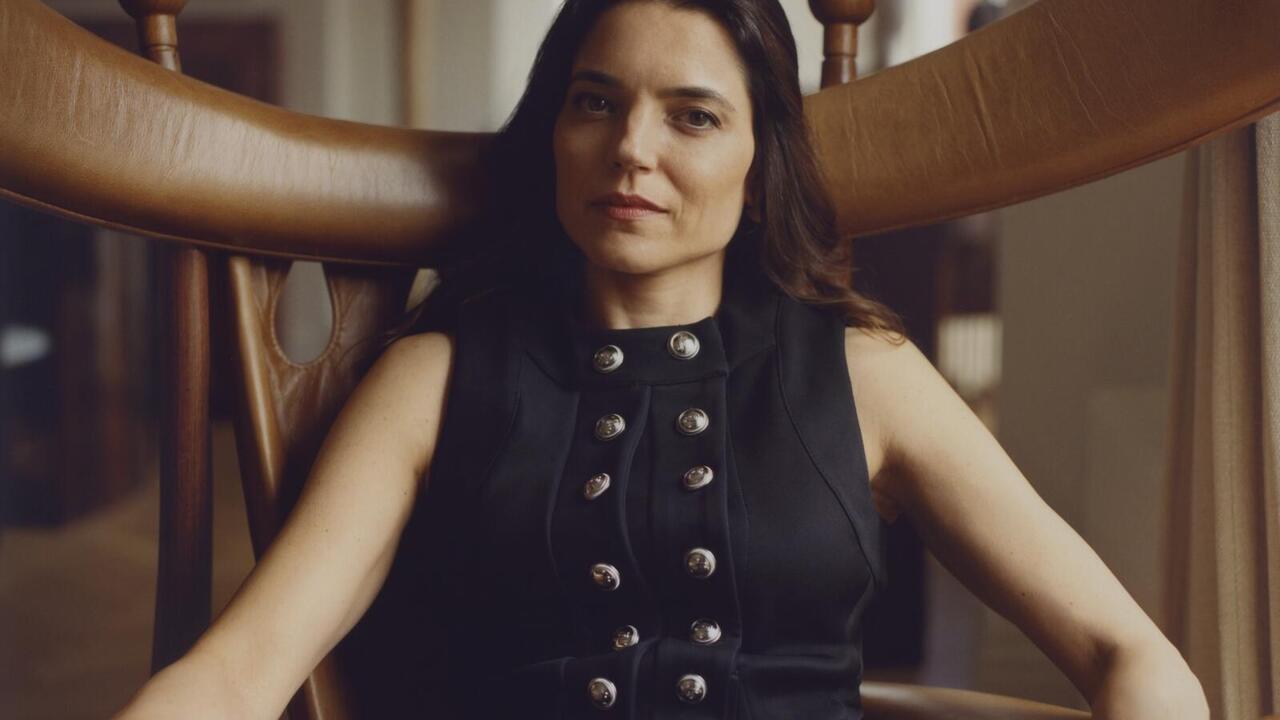Nathalie du Pasquier: My Influences
The French artist Nathalie du Pasquier recollects the people, images and places that have shaped her career
The French artist Nathalie du Pasquier recollects the people, images and places that have shaped her career

The French artist Nathalie du Pasquier has lived and worked in Milan since 1979. Two years after she arrived in the city, Ettore Sottsass founded the design collective Memphis, whose riotous postmodern style – a collision of colours, forms and patterns – would help define the aesthetic of the new decade. At the time, Du Pasquier, who had no formal design training, was creating textile patterns for Italian fashion brands such as Fiorucci and Naj Oleari with the encouragement of her partner, George Sowden, who had worked with Sottsass at Olivetti. The pair was among the Memphis group’s original members. Du Pasquier’s graphic, exuberant patterns covered the surfaces of Memphis creations until 1987, when she decided to dedicate herself to painting. From the still lifes and surrealist-inflected landscapes of the late 1980s and early ’90s, her work has gradually moved towards more abstract compositions – many are paintings of constructions she has created herself. (She defines herself as ‘a painter who makes her own models’.) Earlier this year, ‘Big Game’, a solo exhibition of her works on paper, spanning more than 35 years, was held at Exile, Berlin, and a collection of her unpublished drawings from 1981–87, Don’t Take These Drawings Seriously, designed and edited by Omar Sosa, was published by powerHouse books in February. Her work is on show at Exile as part of the group exhibition ‘Ausstellung 61’ until 10 October, with a further solo show to follow at the gallery in March 2016.

It is a strange exercise to go back in time and try to remember the things that have shaped the course that my life and work have taken. At the time, you rarely recognize what influences the way you see the world and respond to it; it’s only when you look back that the patterns start to emerge.
My first influences were, of course, my parents: from my mother, who was an art historian, I learned a classical way of looking at classical art; my father, who was a virologist, taught me a more naturalistic perspective on different aspects of the world. I was born in the late 1950s in Bordeaux – a port town that, at that time, still did a lot of trade with Africa. I remember many hours spent walking along the quays, watching the ships being unloaded – Okoume timber, coffee, cacao, cargo from far away. At the age of 18, as soon as I had finished school, I decided to leave for west Africa with a group of friends; I was no longer living with my parents and a chance came to sail to Gabon. That was the beginning of life: it is always different from what you expect.

In Gabon, I discovered the relativity of taste. As a child, I had been a fervent reader of Tintin by Hergé, but in west Africa, in 1975, I realized that the Africa of Tintin’s adventures wasn’t quite the whole picture. In Gabon, I imagined being a peintre en lettres – a sign painter, writing words and sentences above shops and on cars. The signs were often simple – capital letters, colours, quite dense. Sometimes, the painters would copy brand logos in a way that made them look completely different. I saw painters working in the street; I felt I could be good at it. But it was just a dream: sign-painting was not a job for white French girls. I gathered shells on the beach when I was not busy with the odd jobs I found, and it was there that I began making my first drawings.
Later, in 1979, when I started designing textiles, people told me that they had the look of African fabrics, but when I was in Gabon I was absorbing patterns in the same way I was listening to the music in the bars and on the radio: enjoying them in an unfocused kind of way, not thinking too much about it. The history of textiles is so rich and global – motifs have been travelling from one country to another with small changes for centuries. I remember spending an afternoon in a library in 1979, looking at traditional French textiles and realizing that everything had been done already – it was just a question of scale and colour.

I came back to France in 1976 but, at the end of 1978, after some more travelling and jobs here and there, I left for Rome to work as an au pair. (A good way to be independent and not have to worry about a place to stay.) When I was 13, I had visited Italy with my mother, who introduced me to many beautiful things. We had started our trip in Ravenna, where we saw the wonderful Byzantine mosaics. They seemed to fit the architecture so well, beyond being decoration, to the point that it didn’t make sense to think in terms of which came first. This is something that has stayed with me.
Going back to Italy as an adult, I was charmed by the anarchic spirit of the people (so different from the French!), by the beauty that I found everywhere, by the light, by the way of living with ancient things entirely naturally – without transforming the place into a museum – by the food, by the fact of being a foreigner. I decided to stay and the following year, in 1979, I moved to Milan. I was still drawing, and thought that I would try to make a living from my drawings. Maybe I could find work as an illustrator.
Not long after arriving in Milan, I met a group of designers. Design was a completely new world for me: finally, it felt like I had found the modernity of my time! For the first time, I wanted to learn about – and take part in – European culture. Milan was the perfect place to discover the stylistic evolution of the 20th century, and to work out what it meant to be contemporary. I chose it because, compared with other Italian cities, it was not overwhelmed by the beauty of the past. Much of Milan was built in the 1930s and ’40s but, because it suffered heavy bombardment during World War II, there are also many interesting buildings from the 1950s and ’60s. I was fascinated by the architecture. I was also trying to find my own starting point for modernity: looking at what had happened at the beginning of the century when industry and new ways of building and producing were starting.

I met my boyfriend George Sowden, a British designer, shortly after I arrived. Through him, I started to understand what design was; before then, I didn’t know that there was such a thing. He encouraged me to design textiles and, instead of working as an illustrator, I started selling my designs to fabric manufacturers around Milan.
Through George, I met Ettore Sottsass, a designer whose work was the opposite of academic. For him, the centre and the suburb provided equal inspiration, with no hierarchy of style. For a person like me, who skipped university, this attitude fitted perfectly. Sottsass’s books are an aspect of his work that has certainly influenced me – his sensibility for graphics and words. I saw a piece of his in a gallery called Esercizio Formale (Formal Exercise, 1979). It consisted of an a4 notebook with a handwritten label in the middle. On every page was a drawing he had done – perhaps of a Greek landscape or an Indian temple or a piece of furniture – accompanied by text that he had copied from various sources. The whole booklet was not about ‘design’, but it managed both to convey a quantity of information and to leave things open to interpretation – the guiding logic was that of the artist’s poetic imagination. I think I had that book and other publications Sottsass made throughout his career at the back of my mind when I was making my own limited editions years later.
Sottsass founded Memphis – a collective of designers and architects – in 1980, and George and I were part of it. George suggested that I work on the ‘decorated surfaces’ of the furniture that he was making. After modernism’s abandonment of decoration, we wanted to make the decorated surface the protagonist again, and not just something added on top. For Memphis, the ‘decorated surface’ was something quite different to the ‘decorated object’. I became interested in what had happened in Vienna in the first decades of the 20th century where, just as industrial production was starting to influence the design of things – and in spite of Adolf Loos’s famous equation of ornament and crime – the Wiener Werkstätte had been exploring a very precise form of decoration that was totally different to the eclecticism of the 19th century. For me, designing pattern is a way to condense a state of mind, memory, aspirations and more without having to be too clever.
By the end of 1986, the Memphis group was in crisis and I was a bit exhausted by the excesses and overexcitement of the early 1980s. I started to wonder whether it was a good idea to go on producing all these new things, as a designer is supposed to do. I knew that artists were painting again: in Italy, we had the transavanguardia. I remember a particularly beautiful show by Mimmo Paladino at Galleria Toselli in 1986 and Sottsass showing me a wonderful book – handmade, with a copper cover – that Francesco Clemente, who was a friend of his, had made while in India. Art was not only that intellectual, difficult thing of the 1960s and ’70s: it was possible to paint images, and that was what I was going to do.

After that, I spent much of the 1990s discovering, or rediscovering, art history – thinking about the connections between painters through the ages, from Roman paintings (in particular the frescoes at Pompeii), to medieval miniatures, to early Renaissance works, to Italian novecento artists: Giorgio de Chirico, Giorgio Morandi, Mario Sironi. At that time, I was also painting a lot of still lifes and landscapes, but my work since has evolved into something less to do with real objects and more to do with abstract shapes. In 1997, I met a Korean painter, Chung Eun-Mo, who lives in Umbria. For years, we have met quite regularly for a day or two in different parts of the country with the excuse of seeing an exhibition. She is an abstract painter, but her work starts in dialogue with classical art and, in particular, with Italian art from the Renaissance. I am also interested in understanding that link between geometry and representation of space – the ambiguity of how three dimensions render on a flat plane – which really comes into focus in the perspectival experiments of the Renaissance. But adventures are like that: you follow tracks, you don’t follow ideologies.






















